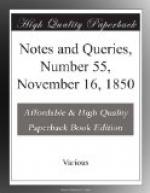“Post dies ergo venit ad insulam rex, et residens sub divo jussit Augustinum cum sociis ad suum ibidem adveire colloquium; caverat enim ne in aliquam domum ad se introirent, vetere usus augurio, ne superventu suo, si quid maleficae artis habuissent, eum superando deciperent.”—Hist. Eccles., l. i. c. 25.
It was cross-legged that Lucina was sitting before the floor of Alemena when she was deceived by Galanthes. In Devonshire there is still a saying which recommends “sitting cross-legged to help persons on a journey;” and it is employed as a charm by schoolboys in order to avert punishment. (Ellis’s Brand, iii. 258.) Were not the cross-legged effigies, formerly considered to be those of Crusaders, so arranged with an idea of the mysterious virtue of the position?
RICHARD J. KING.
Twickenham—Did Elizabeth visit Bacon there?—I believe all the authors who within the last sixty years have written on the history of Twickenham, Middlesex (and among the most known of these I may mention Lysons, Ironside, and John Norris Brewer), have, when mentioning Twickenham Park, formerly the seat of Lord Bacon, stated that he there entertained Queen Elizabeth. Of this circumstance I find no account in the works of the sixteenth and seventeenth centuries. His lordship entertained her at Gorhambury in one of her progresses; and I would ask if it be possible that Twickenham may have been mistaken for his other seat of Gorhambury? It is well known Queen Elizabeth passed much of the latter part of her life at Richmond, and ended her days there; and in Mr. Nares’ Memoirs of Lord Burghley there is an account of her visit to Barn-Elms; and there is also a curious description of her visit to Kew (in that neighbourhood) in the Sydney Papers, published by Arthur Collins, in two vols. folio, vol. i. p. 376., in a letter from Rowland Whyte, Esq. Had Lord Bacon received her majesty, it must most probably have been in 1595. But perhaps some of your readers may be able to supply me with information on this subject.
D.N.
Burial towards the West.—The usual posture of the dead is with the feet eastward, and the head towards the west: the fitting attitude of men who look for their Lord, “whose name is The East,” and who will come to judgement in the regions of the dawn suddenly. But it was the ancient usage of the Church that the martyr, the bishop, the saint, and even the priest, should occupy in their sepulture a position the reverse of the secular dead, and lie down with their feet westward, and their heads to the rising sun. The position of the crozier and the cross on ancient sepulchres of the clergy record and reveal this fact. The doctrine suggested by such a burial was, that these mighty men which were of old would be honoured with a first resurrection, and as their Master came on from the east, they were to arise and to follow the Lamb as He went; insomuch that they, with Him, would advance to the Judgement of the general multitudes,—the ancients and the saints which were worthy to judge and reign. Now, Sir, my purpose in this statement is to elicit, if I may, from your learned readers illustrations of this distinctive interment.




